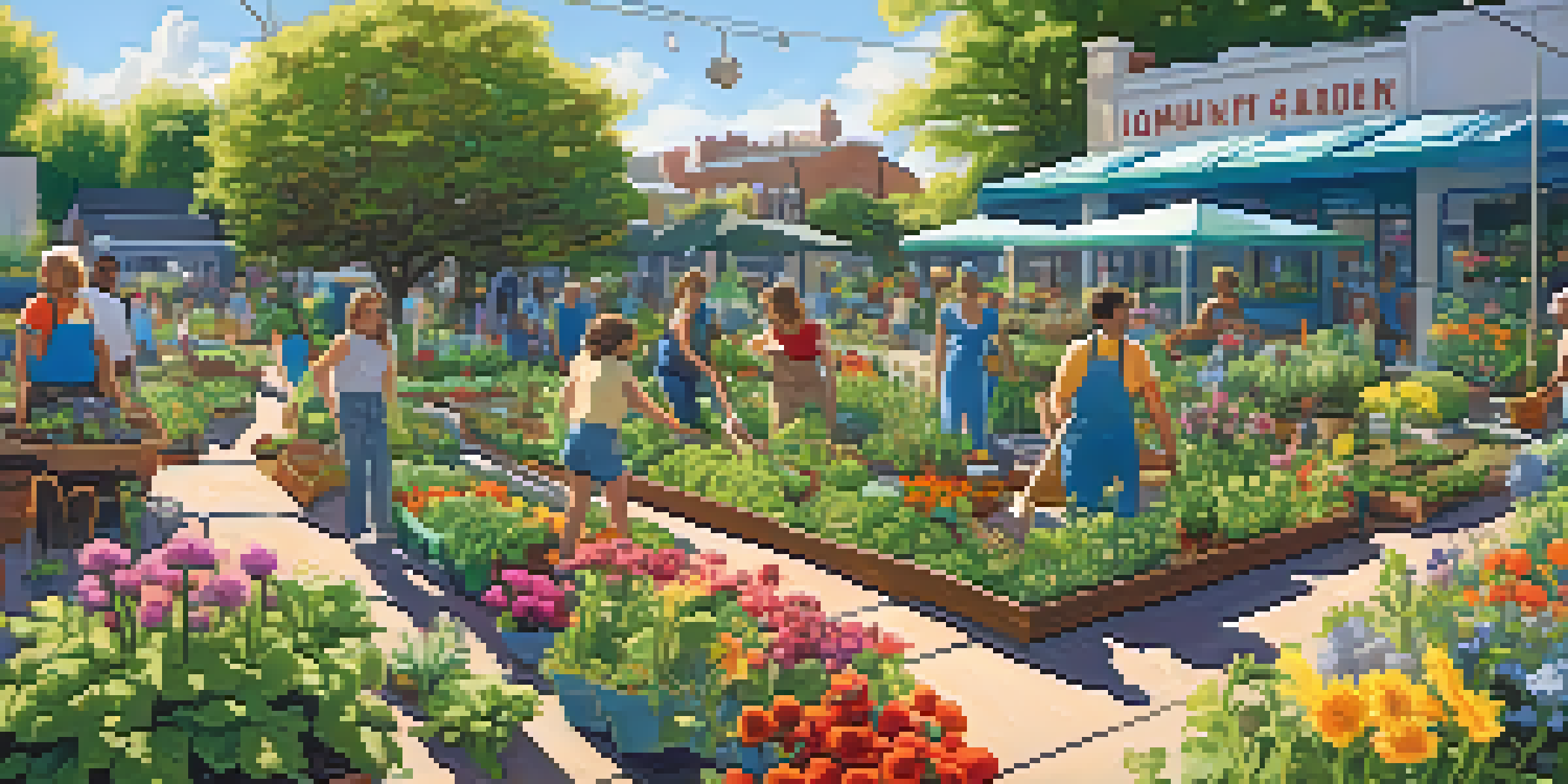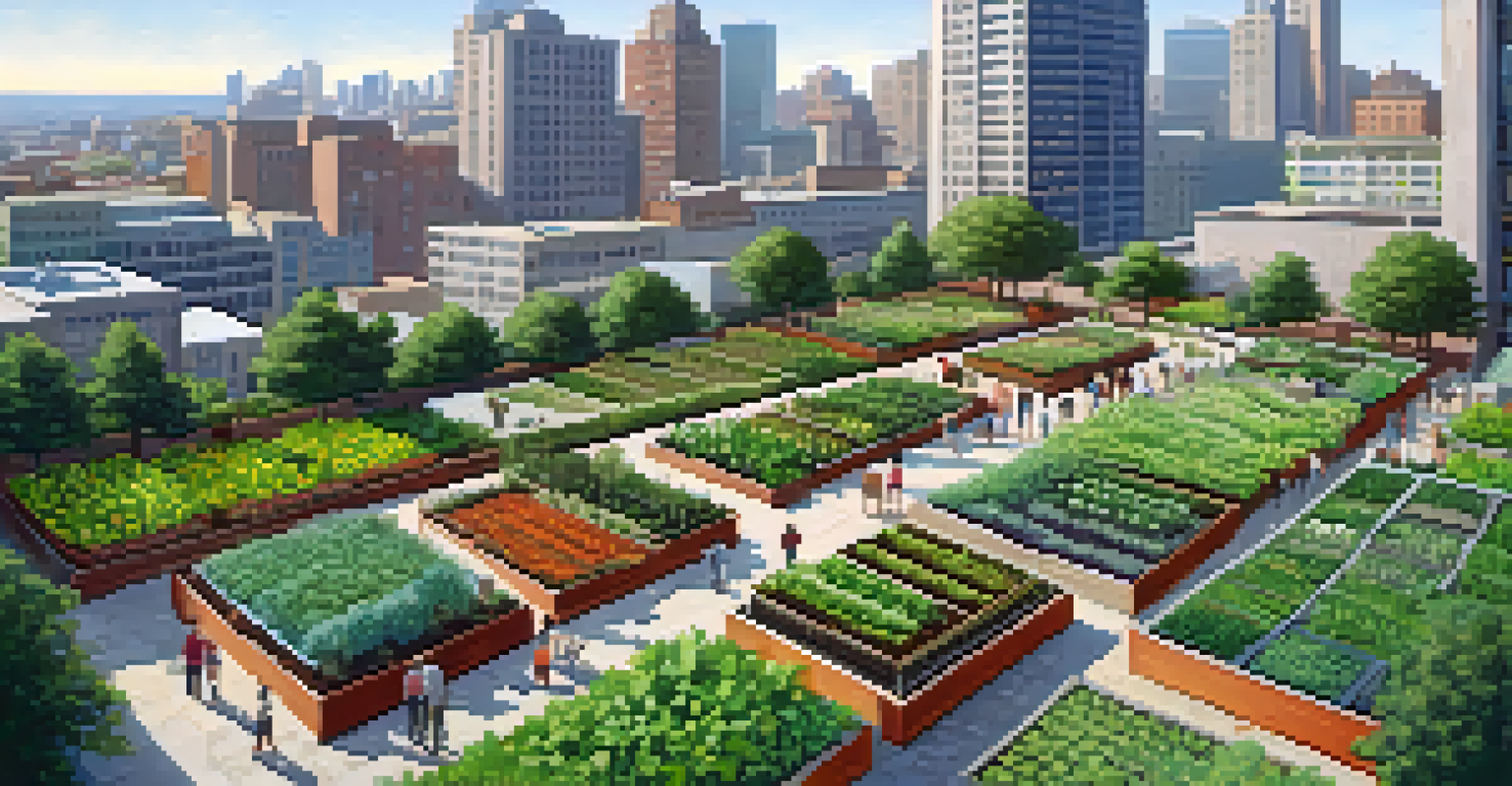Community Gardens: A Green Solution for Urban Food Deserts

Understanding Urban Food Deserts and Their Impact
Urban food deserts are areas where residents lack easy access to fresh, healthy food. This situation often leads to unhealthy eating habits and contributes to various health issues, like obesity and diabetes. Imagine living in a neighborhood with fast food chains on every corner but no grocery stores nearby—it’s a frustrating reality for many.
The future will be green, or not at all.
Food deserts can create a cycle of poverty and poor health, affecting entire communities. When families can't find affordable, nutritious food, they often resort to processed options that are less beneficial. These choices not only impact individual health but can also strain local healthcare systems.
Addressing food deserts is crucial for promoting a healthier urban environment. Community gardens emerge as a proactive solution, providing access to fresh produce while fostering community spirit. They offer a chance to break the cycle of poor nutrition and create a vibrant, supportive atmosphere.
What Community Gardens Are and How They Work
Community gardens are shared plots of land where neighbors come together to grow fruits, vegetables, and flowers. These spaces are typically managed by local residents who decide what to plant and how to maintain the garden. It’s like having a mini-farm right in the heart of the city, bringing nature closer to home.

By pooling resources, community members can cultivate fresh produce, which can be distributed among themselves or sold at local markets. This not only provides access to healthy food but also encourages collaboration and strengthens community bonds. Think of it as a potluck where everyone contributes their skills and efforts for a common goal.
Urban food deserts harm health
Lack of access to fresh food in urban food deserts contributes to unhealthy eating habits and increases health issues like obesity and diabetes.
In many cases, community gardens also incorporate educational programs, teaching participants about sustainable farming and nutrition. These initiatives empower individuals to make healthier choices while providing hands-on experience in gardening. It’s a win-win that cultivates not only plants but also knowledge and camaraderie.
Benefits of Community Gardens in Urban Areas
Community gardens offer numerous benefits beyond just providing fresh food. They enhance urban biodiversity by creating green spaces that attract pollinators and other wildlife. Imagine walking through a neighborhood bustling with flowers and buzzing bees—it's not just visually appealing; it supports the ecosystem.
You can't just sit back and wait for someone else to solve the problem. You have to take action.
Moreover, these gardens play a pivotal role in improving mental health. Gardening can be a therapeutic activity, reducing stress and fostering a sense of accomplishment. Community gardens serve as peaceful retreats amidst the urban hustle, providing a space for reflection and relaxation.
Additionally, community gardens can boost local economies by promoting small-scale agriculture. They create opportunities for local businesses and farmers’ markets, encouraging residents to buy local. This not only keeps money within the community but also supports sustainable practices.
Challenges Facing Community Gardens
While community gardens offer great benefits, they are not without challenges. Securing land can be a significant hurdle, as urban areas often have high real estate values. Community members may need to advocate for their gardens to ensure they have a permanent place to grow.
Funding can also pose a challenge, as many community gardens rely on grants, donations, or volunteer work to maintain their operations. Without consistent financial support, these gardens may struggle to thrive. It's like trying to keep a plant alive without watering it—eventually, it will wither.
Community gardens foster unity
These shared spaces not only provide fresh produce but also strengthen community bonds by encouraging collaboration and shared responsibility.
Additionally, community gardens require ongoing commitment from participants to remain successful. If interest wanes or community members move away, the garden may lose its vitality. Building a strong, engaged community is essential for sustaining these green spaces over time.
How to Start a Community Garden in Your Neighborhood
Starting a community garden can be an exciting venture for any neighborhood. First, gather a group of interested residents and discuss the idea—community buy-in is key! Create a plan outlining the garden's purpose, what to grow, and how to maintain it. This process is like laying the foundation for a house; without it, the structure will struggle to stand.
Next, identify a suitable plot of land—this could be an empty lot, a park, or even a schoolyard. Reach out to local authorities to secure permission and discuss any necessary permits. It's essential to ensure that the chosen site has access to sunlight and water to help your plants flourish.
Once the space is secured, organize a community workday to prepare the garden. This could involve clearing debris, building raised beds, or planting seeds. Engaging everyone in the setup fosters a sense of ownership and excitement, setting the stage for a thriving garden.
Success Stories: Community Gardens Making a Difference
Across the country, numerous community gardens have transformed urban food deserts into thriving green spaces. For example, the Incredible Edible initiative in Todmorden, England, encourages residents to grow food in public spaces, leading to a remarkable increase in local food production. It's a shining example of how community spirit can change lives.
Closer to home, cities like Detroit have seen a resurgence in community gardens as a solution to food insecurity. With the help of local organizations, residents have turned vacant lots into lush gardens, providing fresh produce to those in need. These success stories highlight the potential of community gardens to foster resilience and empowerment.
Challenges hinder garden success
Securing land and funding, along with maintaining community interest, are significant hurdles that community gardens must overcome to thrive.
As more cities recognize the importance of community gardens, we can expect to see even greater innovations and collaborations. They not only address immediate food needs but also inspire communities to come together and work towards a sustainable future. It’s a heartening reminder that change often starts at the grassroots level.
The Future of Community Gardens and Urban Farming
Looking ahead, community gardens are poised to play an even more significant role in urban environments. As cities continue to grapple with food deserts and environmental challenges, these green spaces offer practical solutions. They can adapt to various urban settings, from rooftops to vacant lots, making them a versatile option for food production.
Moreover, urban farming is gaining traction as part of a broader movement towards sustainability. By integrating gardens into urban planning, cities can prioritize green spaces that benefit both residents and the environment. Imagine vibrant neighborhoods that not only feed their inhabitants but also promote biodiversity and resilience against climate change.

As communities recognize the value of local food systems, we can expect to see increased support for community gardens from local governments and organizations. This shift can create a ripple effect, inspiring more people to engage in gardening and sustainable practices. The future is bright for those willing to dig in and nurture their neighborhoods.